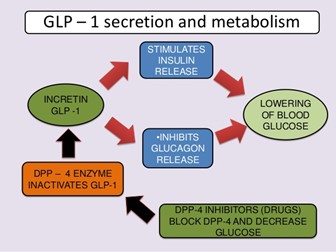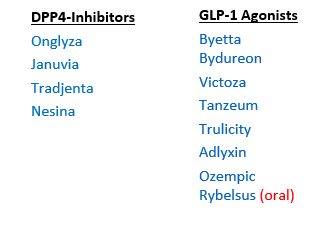
June 15, 2021
DPP4 Inhibitors vs GLP-1 Agonists
There are no guidelines that support the combined use of a GLP‐1 agonist and a DPP‐4 inhibitor.
More and more evidence is showing that the use of DPP4 Inhibitors and GLP‐1 Receptor Agonists in
combination, is a practice worth changing. Together, this combination does not provide clinical benefit due to
similar mechanisms of action (see picture below). More on, ADA and AACE Guidelines prefer GLP1‐RA over
DPP4i for patients with established ASCVD or indicators of high ASCVD risk, CKD 3, or heart failure1.
Another update recommends considering glucagon‐like peptide‐1 [GLP‐1] receptor agonists for high‐risk
patients with CVD who have type 2 diabetes, which is in line with the findings of recently published clinical
trials, including the LEADER (ClinicalTrials.gov identifier: NCT01179048) trials2.
DPP‐4 inhibitors primarily target the postprandial plasma glucose (PPG), whereas, GLP‐1 receptor agonists
target fasting plasma glucose (FPG) as well as PPG. This is the reason a higher A1c lowering effect is observed
with GLP‐1 agonists, due to the FPG lowering effect.
DPP4 Inhibitors effect on GLP-1 secretion


GLP-1RAs provide superior glycemic control and weight loss vs. DPP-4 inhibitors in patients with T2D. DPP-4 inhibitors may sometimes be preferred to a GLP-1RA if weight is not a concern, oral administration is a desirable feature or when a GLP-1RA cannot be tolerated. Otherwise, patients taking both a DPP4i and GLP1-RA could benefit from discontinuing the DPP4i.
1American Diabetes Association. Standards of medical care in diabetes–2017. Diabetes Care. 2017;40(Suppl. 1):S6-S10
2https://clinicaltrials.gov/ct2/show/NCT01179048